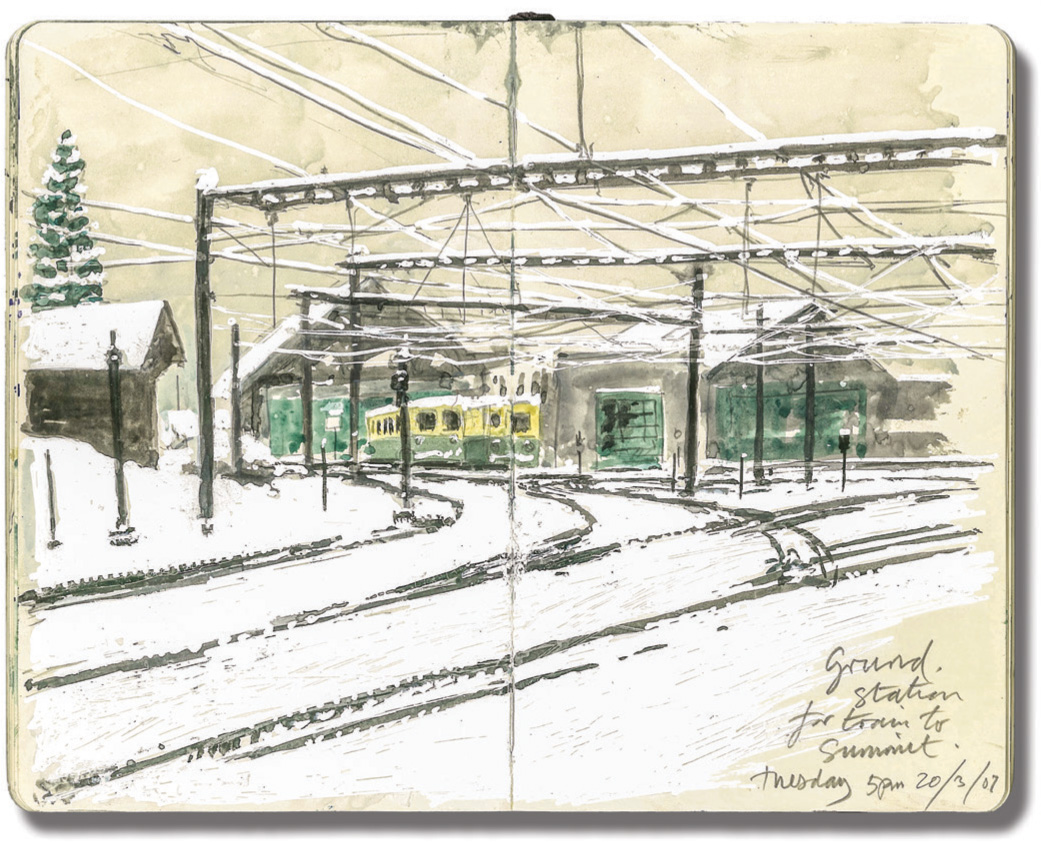
Grund Station, Switzerland, Phil Carter.
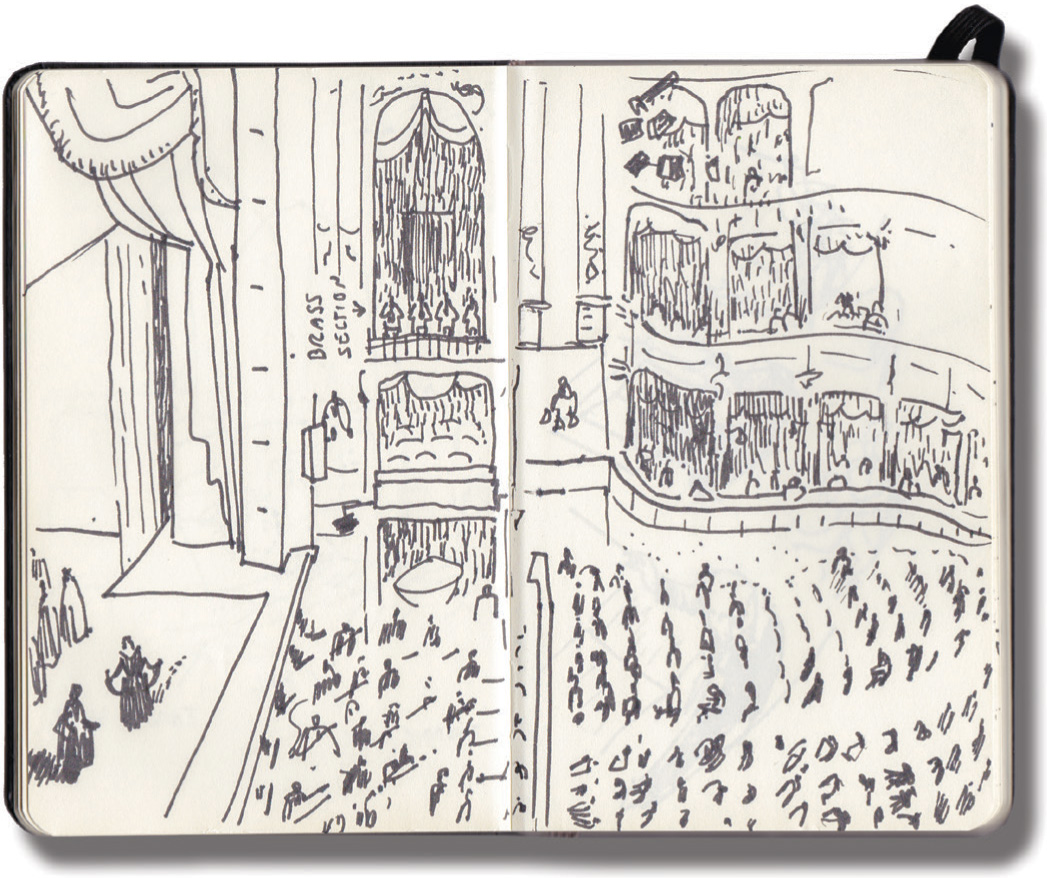
Budapest Opera House, Andrew Baker.
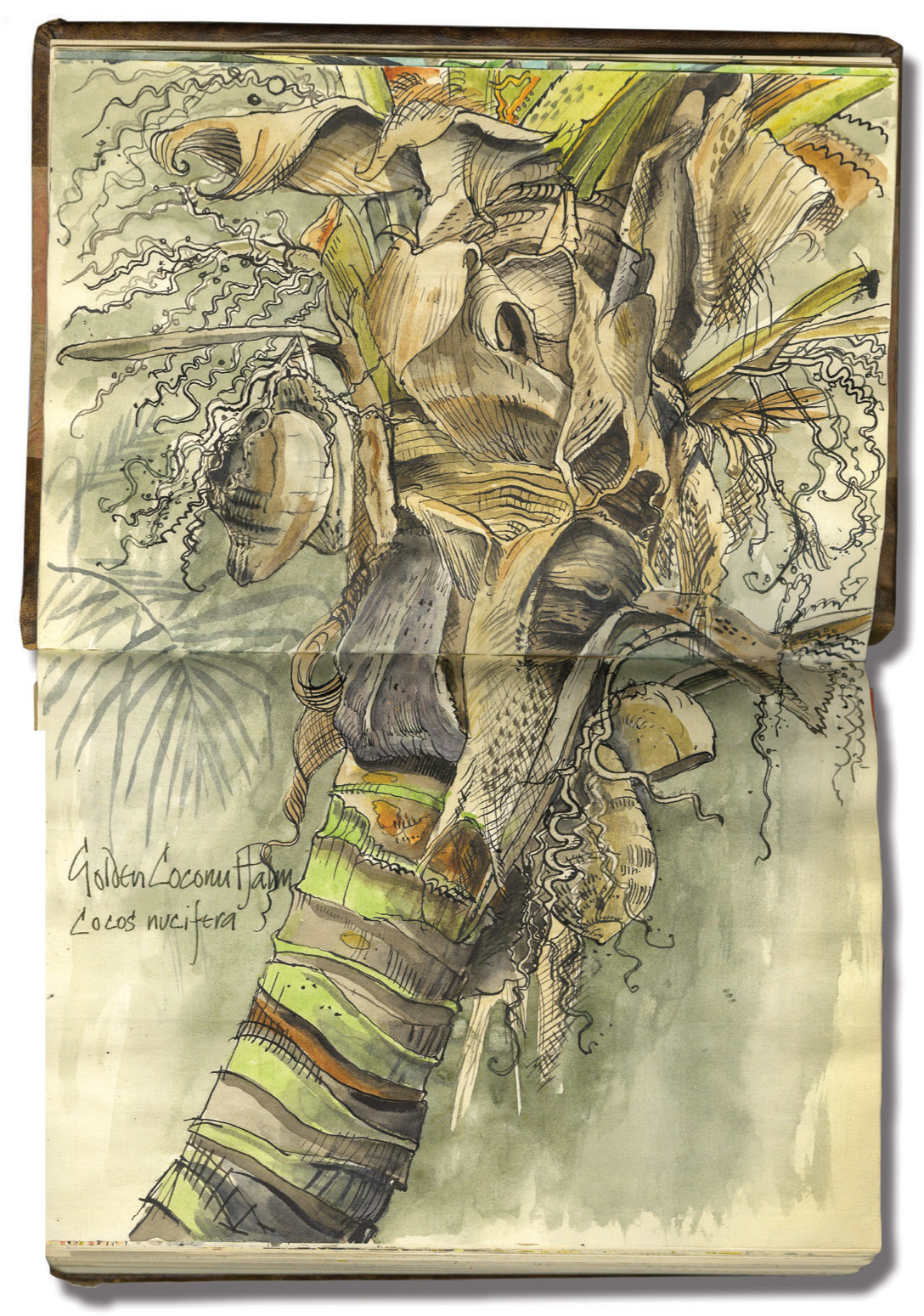
Golden Coconut Palm, Martin Ursell.
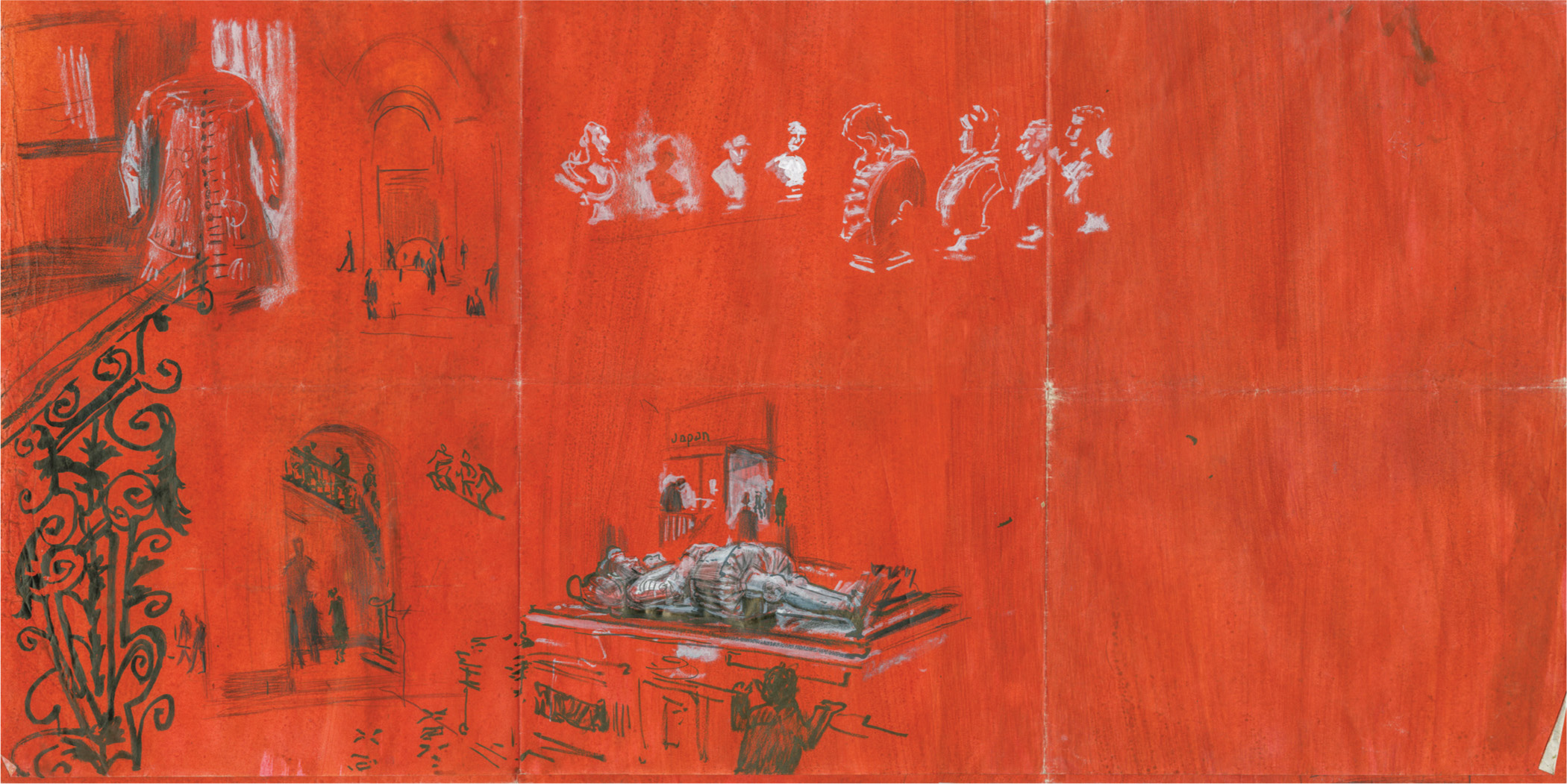
The Victoria and Albert Museum, London, Aldous Eveleigh.
KEEPING SKETCHBOOKS


THE CROWOOD PRESS
First published in 2016 by
The Crowood Press Ltd
Ramsbury, Marlborough
Wiltshire SN8 2HR
www.crowood.com
This e-book first published in 2016
Martin Ursell 2016
All rights reserved. No part of this publication may be reproduced or transmitted in any form or by any means, electronic or mechanical, including photocopy, recording, or any information storage and retrieval system, without permission in writing from the publishers.
British Library Cataloguing-in-Publication Data
A catalogue record for this book is available from the British Library.
ISBN 978 1 78500 109 3
Frontispiece: From left to right clockwise: Grund Station, Switzerland, Phil Carter; Golden Coconut Palm, Kew, Martin Ursell; The Victoria and Albert Museum, London, Aldous Eveleigh; Budapest Opera House, Andrew Baker. In these four images the overriding feeling created is one of atmosphere and a sense of place. The scarlet wash across this double by Aldous really helps convey the richness and monarchic nature of this part of the Victoria and Albert Museum. Likewise the grey green wash and almost monotone treatment of the Golden Coconut help evoke the intense humidity and mistiness of the Palm House at Kew in London. In complete contrast Phil Carters wonderfully atmospheric drawing of Grund Station in Switzerland looks bitingly cold and raw. I have been to this station and when I first saw this sketchbook double I was immediately transported straight back there. Phil captures this place quite brilliantly. With his pen drawing of the extremely decorative Budapest Opera House, Andrew Baker manages to give a real feeling of what it is like inside whilst using relatively few lines. This sketchbook double has a marvellous feeling of space and grandeur. Andrew makes simplifying very ornate subject matter like this look easy when in fact it is fiendishly difficult to draw in this succinct and unfussy way. One can imagine how much detail Andrew decided to leave out of this drawing, however it looks as if he has drawn everything, nothing seems to be missing.
Title page: Kings Sketchbook, Martin Ursell.
Dedication
For Nick Boyle and Abul Kalam, what a very wonderful time we had drawing our way around India and Bangladesh; the video bus, the bucket flush, the warm plate and the human leg warmers, the whole thing a diamond chance!

Sacred Cows, Jaipur, India by Martin Ursell.
 CONTENTS
CONTENTS
FOREWORD
by Professor John Vernon Lord
We have to remember that what we observe is not nature herself, but nature exposed to our method of questioning.
Werner Heisenberg, Physics and Philosophy: The Revolution in Modern Science (1958).
 hen I was a first year art student in 1956 our first day was to go outdoor sketching, which we did every Monday for a year, irrespective of the weather. In those days sketchbooks formed part of your assessment. I can recall our teacher, Bill Hodgson, overwhelming me with ways of looking during those early days of art school. He would say such things as look for the darkest and lightest aspects of what you can see; look at the shapes of the spaces in between the objects; keep an eye out for the unusual and the anecdotal; try to distinguish the various textures that you can see before you and invent ways of rendering them; look at the expressions on peoples faces, capture their body language, their gestures and hand movements; use different instruments for drawing and try drawing on different papers; try drawing on a large scale and also try drawing on a small scale; try drawing freely and try drawing tightly, but remember drawing freely isnt necessarily the only way of experimenting, for experimenting in mark-making can be done in many different ways loosely and tightly! We would be encouraged to draw with just lines for some sessions and by only using tones for others. We would discuss what to leave in and what to leave out. He would talk about compositional unity and relationships between objects, about proportion, emphasis, rhythm and balance, and perspective. He made us look and listen rather than just see and hear. He gave us that feeling that ideas emerge from attempting to draw what was in front of us. He sharpened our sense of observation. He believed that looking at the world around us, and trying to interpret it by drawing and sketching, should stimulate our imagination. After looking over your shoulder at your drawing he would also say, enjoy yourself.
hen I was a first year art student in 1956 our first day was to go outdoor sketching, which we did every Monday for a year, irrespective of the weather. In those days sketchbooks formed part of your assessment. I can recall our teacher, Bill Hodgson, overwhelming me with ways of looking during those early days of art school. He would say such things as look for the darkest and lightest aspects of what you can see; look at the shapes of the spaces in between the objects; keep an eye out for the unusual and the anecdotal; try to distinguish the various textures that you can see before you and invent ways of rendering them; look at the expressions on peoples faces, capture their body language, their gestures and hand movements; use different instruments for drawing and try drawing on different papers; try drawing on a large scale and also try drawing on a small scale; try drawing freely and try drawing tightly, but remember drawing freely isnt necessarily the only way of experimenting, for experimenting in mark-making can be done in many different ways loosely and tightly! We would be encouraged to draw with just lines for some sessions and by only using tones for others. We would discuss what to leave in and what to leave out. He would talk about compositional unity and relationships between objects, about proportion, emphasis, rhythm and balance, and perspective. He made us look and listen rather than just see and hear. He gave us that feeling that ideas emerge from attempting to draw what was in front of us. He sharpened our sense of observation. He believed that looking at the world around us, and trying to interpret it by drawing and sketching, should stimulate our imagination. After looking over your shoulder at your drawing he would also say, enjoy yourself.
Sketching often implies a hurried approach to drawing. Personally I do not think this is necessarily the case.
Sketching is often defined as a quick informal drawing, often a study for a later elaboration. I notice, in the Collins English Dictionary, that the word sketch derives from the Latin word schedius meaning hastily made and the Greek skhedios meaning unprepared. The spirit of these verbal connections is understood but quite often a sketch might well be a carefully wrought drawing, rather than a hurried one. Definitions can sometimes be too restricting, for the same dictionary defines drawing as a picture or plan made by means of lines on a surface, especially one made with a pencil or pen without the use of colour. Well, surely this confines drawing too narrowly for drawings can equally be made with a brush or other instruments and colour can certainly be applied. The notion that a sketch might be something unprepared (despite it being defined as a plan) is an interesting one for so often we are indeed unprepared for the outcome of a sketch. By sketching we sometimes discover things that we least expected. The very informality of the process sometimes allows us to achieve an image, which hitherto we hadnt felt capable of before. The word experiment comes to mind. There is also the doodle, which means to scribble or draw aimlessly, another notion of being unprepared. Spontaneity and intuition are as important as careful planning. We need to work at both.
To look at something and to commit yourself to describing it as a drawing in a sketchbook is a contemplative act. It involves sharp observation, spontaneous thinking and at the same time a commitment to make sense of what you can see.



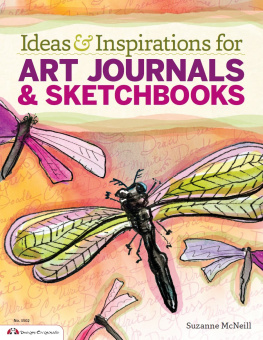



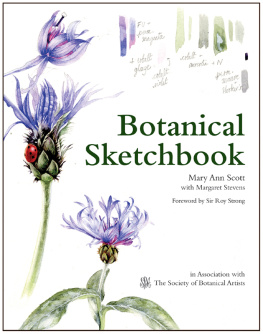

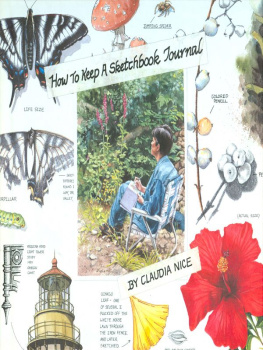
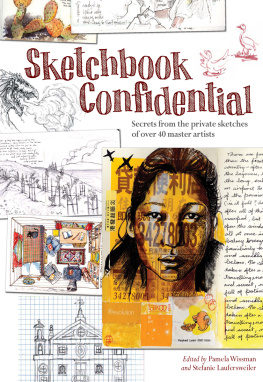
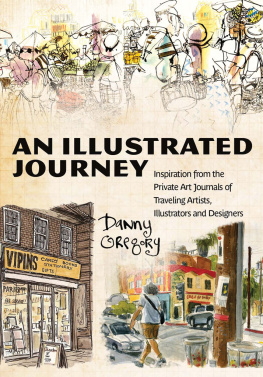
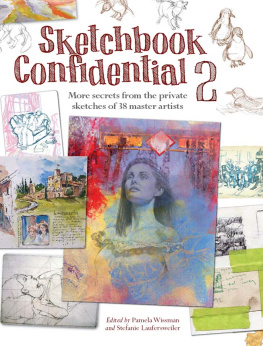








 CONTENTS
CONTENTS hen I was a first year art student in 1956 our first day was to go outdoor sketching, which we did every Monday for a year, irrespective of the weather. In those days sketchbooks formed part of your assessment. I can recall our teacher, Bill Hodgson, overwhelming me with ways of looking during those early days of art school. He would say such things as look for the darkest and lightest aspects of what you can see; look at the shapes of the spaces in between the objects; keep an eye out for the unusual and the anecdotal; try to distinguish the various textures that you can see before you and invent ways of rendering them; look at the expressions on peoples faces, capture their body language, their gestures and hand movements; use different instruments for drawing and try drawing on different papers; try drawing on a large scale and also try drawing on a small scale; try drawing freely and try drawing tightly, but remember drawing freely isnt necessarily the only way of experimenting, for experimenting in mark-making can be done in many different ways loosely and tightly! We would be encouraged to draw with just lines for some sessions and by only using tones for others. We would discuss what to leave in and what to leave out. He would talk about compositional unity and relationships between objects, about proportion, emphasis, rhythm and balance, and perspective. He made us look and listen rather than just see and hear. He gave us that feeling that ideas emerge from attempting to draw what was in front of us. He sharpened our sense of observation. He believed that looking at the world around us, and trying to interpret it by drawing and sketching, should stimulate our imagination. After looking over your shoulder at your drawing he would also say, enjoy yourself.
hen I was a first year art student in 1956 our first day was to go outdoor sketching, which we did every Monday for a year, irrespective of the weather. In those days sketchbooks formed part of your assessment. I can recall our teacher, Bill Hodgson, overwhelming me with ways of looking during those early days of art school. He would say such things as look for the darkest and lightest aspects of what you can see; look at the shapes of the spaces in between the objects; keep an eye out for the unusual and the anecdotal; try to distinguish the various textures that you can see before you and invent ways of rendering them; look at the expressions on peoples faces, capture their body language, their gestures and hand movements; use different instruments for drawing and try drawing on different papers; try drawing on a large scale and also try drawing on a small scale; try drawing freely and try drawing tightly, but remember drawing freely isnt necessarily the only way of experimenting, for experimenting in mark-making can be done in many different ways loosely and tightly! We would be encouraged to draw with just lines for some sessions and by only using tones for others. We would discuss what to leave in and what to leave out. He would talk about compositional unity and relationships between objects, about proportion, emphasis, rhythm and balance, and perspective. He made us look and listen rather than just see and hear. He gave us that feeling that ideas emerge from attempting to draw what was in front of us. He sharpened our sense of observation. He believed that looking at the world around us, and trying to interpret it by drawing and sketching, should stimulate our imagination. After looking over your shoulder at your drawing he would also say, enjoy yourself.